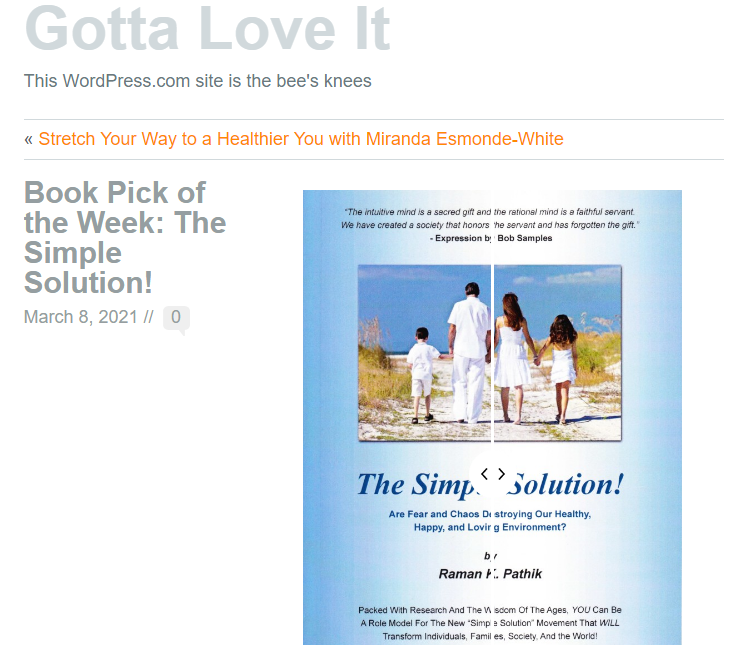by Raman Pathik | Blog
 The breathing process works like a bicycle tire pump. You pull up to empty the Carbon Dioxide (CO2) and other toxins; you push down to fill or “breathe in” air with Oxygen (O2); therefore, the pressure pulls and pushes air throughout the whole body. Inhaling and exhaling air is the process that provides O2 to all parts of the body, and is required to support and sustain life. This is medically referred to as physiological respiration, defined as the transport of O2 from the outside air to the cells within tissues and the transport of CO2 back to the outside air. Respiration is also referred to as ventilation. The scientific term defined by the American Heritage Medical Dictionary, © 2002, published by Houghton Mifflin Company, is eupnea—“Easy, free respiration as is observed normally under resting conditions.” (more…)
The breathing process works like a bicycle tire pump. You pull up to empty the Carbon Dioxide (CO2) and other toxins; you push down to fill or “breathe in” air with Oxygen (O2); therefore, the pressure pulls and pushes air throughout the whole body. Inhaling and exhaling air is the process that provides O2 to all parts of the body, and is required to support and sustain life. This is medically referred to as physiological respiration, defined as the transport of O2 from the outside air to the cells within tissues and the transport of CO2 back to the outside air. Respiration is also referred to as ventilation. The scientific term defined by the American Heritage Medical Dictionary, © 2002, published by Houghton Mifflin Company, is eupnea—“Easy, free respiration as is observed normally under resting conditions.” (more…)
by Raman Pathik | Baby Breath, Blog
There are many positive aspects to meditation and the silence of the breath in a healthy lifestyle. The longer you meditate, the more added benefits you will discover as you reach inside your mind and get in touch with your natural, true, spiritual self – the self you were meant to be before the world stepped in and fear, stress, and chaos took over. Below is a partial list of physical, mental, emotional, and healthy lifestyle benefits that you can consciously strive to achieve.
- Inner happiness and peace of mind in your everyday life
- Relief from medical conditions, such as: high blood pressure, mental stress disorders, heart disease, asthma, and other stress-related diseases
- A spiritual enlightenment experience
- Greater self-discovery and self-knowledge about your true self
- Solutions to problems of a personal or professional nature
- New creative insights or latent talents
- Healing and acceptance from the stress and pain of traumatic life events, such as the loss of a loved one, physical or mental abuse, Post-Traumatic Stress Syndrome from war or gang/criminal activity, either experienced yourself or by family members, debilitating injuries, divorce, or other life-altering problems
- Relief from anxiety, confusion, disorientation, or depression
- Freedom from addiction, such as: alcoholism, substance abuse, sexual addiction, or obsessive-compulsive disorders
- Boosting your memory and/or intelligence
- Relief or reduction of chronic physical pain
- Communion with your supreme higher being
- Success in areas of long-term problems, such as weight/diet issues, anger management, passive aggression, shyness, or other unbalanced areas of your life
by Raman Pathik | Baby Breath, Blog
Intro to Baby Breathing with Raman Pathik
The breath I am referring to is not a Yoga breath, nor a transcendental breath, a deep breath, or a meditation breath. These terms have been so over-used that they no longer have specific definitions. They are catch-all phrases.
The breath I am describing in The Simple Solution is the result of cognizant ‘mindful’ awareness of our breathing, which is like the breath flow of an infant. The Simple Solution breath is as natural as a baby breathing.
What is baby breathing?
The phrenic nerve may not be something you have heard of before, but as you read this, it is keeping you alive. This nerve controls the diaphragm muscle, which controls the breathing process. When the diaphragm contracts, the chest cavity expands and creates room for inhaled air. Slow deep breathing improves blood oxygenation, This improves ventilation efficiency for oxygen as shown by blood oxygenation increase, and it reduces systemic and pulmonary blood pressure at high altitude but does not change pulmonary gas diffusion.
How does deep breathing help anxiety? … Abdominal breathing for 20 to 30 minutes each day will reduce anxiety and reduce stress. Deep breathing increases the supply of oxygen to your brain and stimulates the parasympathetic nervous system, which promotes a state of calmness.
 The breathing process works like a bicycle tire pump. You pull up to empty the Carbon Dioxide (CO2) and other toxins; you push down to fill or “breathe in” air with Oxygen (O2); therefore, the pressure pulls and pushes air throughout the whole body. Inhaling and exhaling air is the process that provides O2 to all parts of the body, and is required to support and sustain life. This is medically referred to as physiological respiration, defined as the transport of O2 from the outside air to the cells within tissues and the transport of CO2 back to the outside air. Respiration is also referred to as ventilation. The scientific term defined by the American Heritage Medical Dictionary, © 2002, published by Houghton Mifflin Company, is eupnea—“Easy, free respiration as is observed normally under resting conditions.” (more…)
The breathing process works like a bicycle tire pump. You pull up to empty the Carbon Dioxide (CO2) and other toxins; you push down to fill or “breathe in” air with Oxygen (O2); therefore, the pressure pulls and pushes air throughout the whole body. Inhaling and exhaling air is the process that provides O2 to all parts of the body, and is required to support and sustain life. This is medically referred to as physiological respiration, defined as the transport of O2 from the outside air to the cells within tissues and the transport of CO2 back to the outside air. Respiration is also referred to as ventilation. The scientific term defined by the American Heritage Medical Dictionary, © 2002, published by Houghton Mifflin Company, is eupnea—“Easy, free respiration as is observed normally under resting conditions.” (more…)




